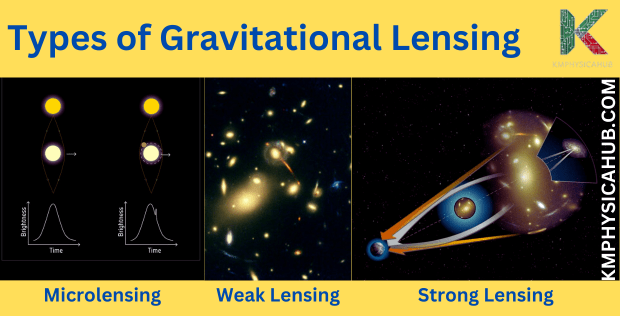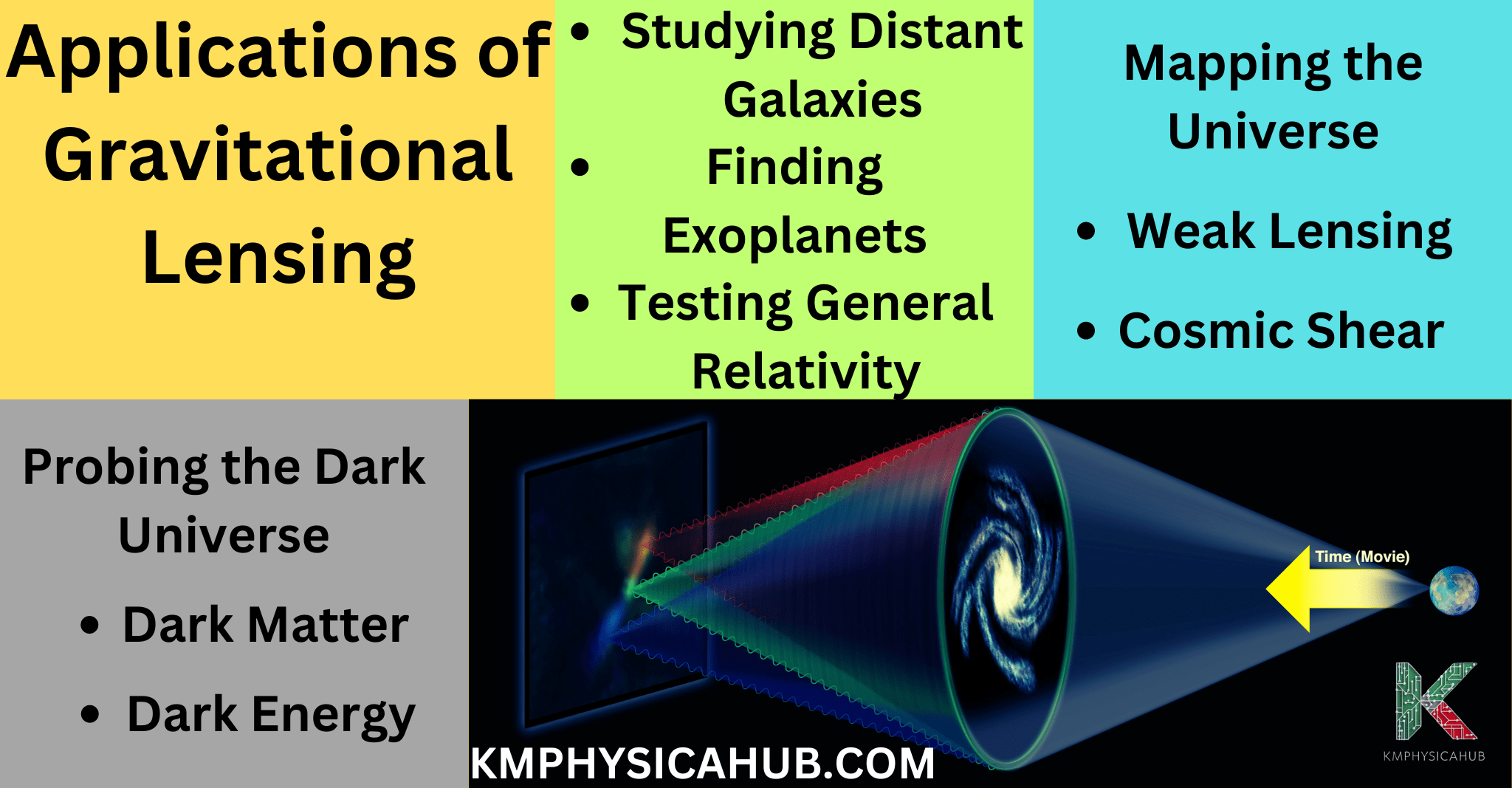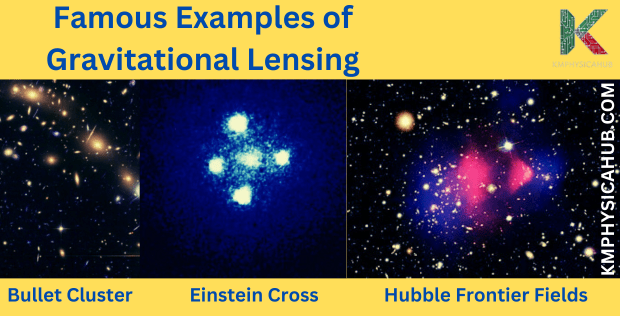Gravitational Lensing: Types, working, Applications and Famous Examples
What is Gravitational Lensing?
Gravitational lensing is basically a reflection of Einstein’s theory of General relativity, where powerful objects such as galaxies or a cluster of galaxies distort the light coming from a far-off source by bending it. This bending of light distorts the shape of the distant object in the sights of the viewer, the size of the object may seem to be much larger than it actually is and even instead of the single object one can see different images of it.
History of Gravitational Lensing
1915: Albert Einstein put forward his theory of General relativity which explained that gravity can bend light.
1919: The solar eclipse observation by Sir Arthur Eddington finds the light coming from distant stars bend when passing nearby the Sun, thus making the gravitational lensing effect a reality.
1930s: Fritz Zwicky suggested that one could use gravitational lensing to study distant galaxies.
1979: A first case of strong gravitational lensing is reported where a quasar is lensed by a galaxy.
1980s-Present: Gravitational lensing as a field has progressed quickly and hundreds of observations and theoretical accounts have been made.
Importance of Gravitational Lensing in Astronomy:
Magnifying distant objects:
It makes it easier for astronomers to observe faint objects that may not be easily detected from the earth.
Probing the invisible:
It assists us in understanding dark matter, which is material that does not reflect light but has mass and gravity.
Testing General Relativity:
Observational data of the lensing effect of gravitation gives considerable support to the theory championed by Einstein.
Understanding the Universe’s evolution:
Gravity lensing tells us about the large scale distribution of matter in the universe and its formation and evolution.
Physics Behind Gravitational Lensing:
Einstein’s General Relativity:
According to Einstein’s theory of General Relativity, gravity is not a force as is commonly believed but the warping of space and time due to the presence of mass and energy. This curvature does influence motion of objects, gasses, fluids or even light. Light being massless traverses in straight line in flat spacetime but it curves in regions influenced by spacetime curvature caused by massive bodies.
Types of Gravitational Lenses
Strong Lensing:
This takes place when a very large body such as a galaxy or huge group of galaxies is placed directly along the line between the source of light and the observer and in effect the light has to pass through this body before reaching the observer. It this case it results in multiple images of the source, arcs or rings.
Weak Lensing:
Happens when the lensing object is not directly in line with the source object. This causes slight warping of the background object’s shape, the distortion patterns of which can be statistically analyzed to create a map of the distribution of matter.
Microlensing:
Happens when a small body such as a star or a planet gets in front of a distant source. This results in a temporary increase in the observed brightness of the source because of the lensing effect.

How Gravitational Lensing Works
Light Bending:
If light is emitted from a distant object, it will curve around another massive object because of the curvature of the space due to gravity.
Image Distortion:
The measured bending angle indicates the extent to which light is bent by the lensing object and depends on the mass of the lensing object, and the distance of the source and the observer. This bending can cause the distant object to appear distorted, magnified or can cause even multiple images of the same object.
Applications of Gravitational Lensing
-
Probing the Dark Universe:
Dark Matter:
Gravitational lensing is a valuable method for mapping dark matter: an unseen substance like black holes that does not emit light but has mass that bends light.
Weak lensing: By studying the distorted image of distant galaxies by dark matter astronomers are able to deduce its distribution in the universe. This has shown that dark matter is not distributed like normal matter but it has more density in the center of galaxies and clusters.
The Bullet Cluster: This particular type of gravitational lensing demonstrates how dark matter is distinct from luminous matter. In the collision of two galaxy clusters, the hot gas was slowed down and the dark matter was sent on a less deviated path further proving its differences.
Dark Energy:
Gravitational lensing is also used in the investigation of dark energy, the phenomenon that has caused the accelerated expansion of the Universe.
Time delays: Information about the time interval between different images of the lensed object can be used to determine a fundamental cosmological parameter – the Hubble constant. It then allows us to investigate how the expansion rate has changed over cosmological time and learn more about the dark energy.
Large-scale structure: Gravitational lensing can be applied for understanding the large-scale structure of the universe, its mass distribution, and its evolution. This information restricts the models of dark energy and its effect on the rate of the expansion of the Universe.
-
Mapping the Universe:
Another use of gravitational lensing is in revealing the matter distribution in the Universe and its overall structure.
Weak lensing:
In weak lensing, distortions of background galaxies are used to map the distribution of matter, including both luminous and non-luminous matter. By using this information, scientists are able to learn how galaxies and galaxy clusters formed and developed.
Cosmic shear:
Weak lensing also identifies the phenomenon of “cosmic shear” where distant galaxies appears to be aligned due to the large scale structure of matter. This alignment gives information about distribution of matter on a very large scale thus giving insight into the structure and evolution of the Universe.
-
Studying Distant Galaxies:
Gravitational lensing acts as a cosmic magnifying glass, allowing astronomers to study distant galaxies in greater detail.
Magnification:
Lensing distorts the light coming from distant galaxies making them appear even brighter and bigger. This makes it possible for astronomers to learn about their characteristics such as their shape, rate of star formation, and metallicity respectively.
Early universe:
Gravitational lensing is useful to observe galaxies in the early stage of the Universe, when they were forming, and changing. The magnification effect enables us to study such distant and low luminosity galaxies, which shed light on the early stages of galaxy formation and evolution.
-
Finding Exoplanets:
Gravitational microlensing is a particular type of lensing where a star or a planet comes in front of another distant star and is widely used for the detection of exoplanets.
Microlensing events:
When a star moves in front of another distant star, the light emitted by the farther star is bent and makes it look larger. If the foreground star has a planet, then due to its gravity there will be a short flash, during which the background star will shine brighter.
Detecting planets:
This method is especially useful in identifying planets which conventional techniques cannot identify including those in faraway star systems or those which have low masses.
-
Testing General Relativity:
Gravitational lensing can also be used to validate Einstein’s theory of General Relativity.
Predictions:
Einstein’s theory defines certain curving of light near large objects, which results in certain types of distortions and enlargements of images.
Observations:
Many of these predictions have been tested through observations of lensing effects and these tests have been shown to agree with General Relativity to high precision.
Alternative theories:
Thus, gravitational lensing can also be used to compare it with the other theories of gravity and learn more about the subject and its possible flaws.

Famous Examples of Gravitational Lensing
The Einstein Cross:
This is one of the best-known examples of the phenomenon of strong gravitational lensing. Quasar, a very bright and distant object, looks like four images creating a cross shape around a foreground galaxy. This effect was predicted by Einstein and and observed in 1980.
The Bullet Cluster:
The Bullet Cluster is a system of two galaxy clusters in the process of merging. Hot gas known as intra-cluster gas emits X-ray radiation used to observe these clusters while the distribution of dark matter is observed through a phenomenon referred to as weak lensing. The separation of the dark matter distribution from the gas distribution constitutes positive evidence for the existence of dark matter.
The Hubble Frontier Fields:
The Hubble Frontier Fields program is a set of deep field images by the Hubble Space Telescope and it targets the massive galaxy clusters. These observations have confirmed a plethora of gravitational lensing effects such as distant faint galaxies lensed by the clusters. This program has greatly enhanced our knowledge on the formation and evolution of galaxies in the early universe.

Future of Gravitational Lensing
Upcoming Telescopes and Observatories:
- The James Webb Space Telescope (JWST):
Due to its highly developed infrared engineering, JWST will be able not only to observe such objects as lensed galaxies but also to study them in detail.
- The Extremely Large Telescope (ELT):
This ground-based telescope will have a mirror diameter of 39 meters making it potentially the world’s largest optical/near-infrared telescope. It will be able to have a better look at gravitational lensing phenomena.
- Space-based telescopes:
Next-generation space-based observatories, such as the Nancy Grace Roman Space Telescope, will be optimized to study the dark energy and dark matter through lensing.
Potential for New Discoveries:
- Discovering new exoplanets:
It is believed that more exoplanets are likely to be discovered through microlensing surveys particularly those occurring far from our solar system.
- Mapping the distribution of dark matter:
It is anticipated that the weak lensing surveys will deliver significantly better pictures of the shape and distribution of dark matter and its history.
- Testing alternative theories of gravity:
The observations made through gravitational lensing can be useful for checking the accuracy of the further theories of gravity and studying gravity in detail.
Conclusion:
The phenomenon of gravitational lensing is one of the greatest discoveries that has changed our perspective on the Universe. It helps us observe what cannot be seen naked, analyze objects that are far away, and experiment with key hypotheses in physics.
As new telescopes continue to be constructed and as more and more advanced techniques are developed for the analysis of lensed systems, gravitational lensing will remain a central means for advancing our understanding of the fundamental nature of the cosmos, gravity, dark matter and the history of the Universe. Clearly, gravitational lensing has the potential to deliver significant new findings and reveal a more complex state of the universe in the near future.
FAQs
Q1. What is gravitational lensing?
A: Gravitational lensing is the phenomenon where light get deflected when it passes through the gravitational field of large masses, which results in distortion and magnification of objects.
Q2. Who predicted gravitational lensing?
A: The phenomenon of gravitational lensing was first hypothesized by Albert Einstein in 1915 in his theory of General Relativity.
Q3. How does mass affect gravitational lensing?
A: The bigger object has a larger mass, which results in a stronger gravitational field and thus, creates stronger lensing impacts on light.
Q4. What are the different types of gravitational lensing?
A:
- Strong lensing:
Produce more than one image of a far-away object.
- Weak lensing:
Distorts the background galaxies in a subtle manner.
- Microlensing:
Slight increase in brightness of a distant star when a foreground star or planet appears to cross its path.
Q5. Write five applications of gravitational lensing in astronomy?
A:
- Studying dark matter and dark energy.
- Mapping the distribution of matter in the Universe.
- Observing distant galaxies and quasars.
- Detecting exoplanets.
- Testing General Relativity.